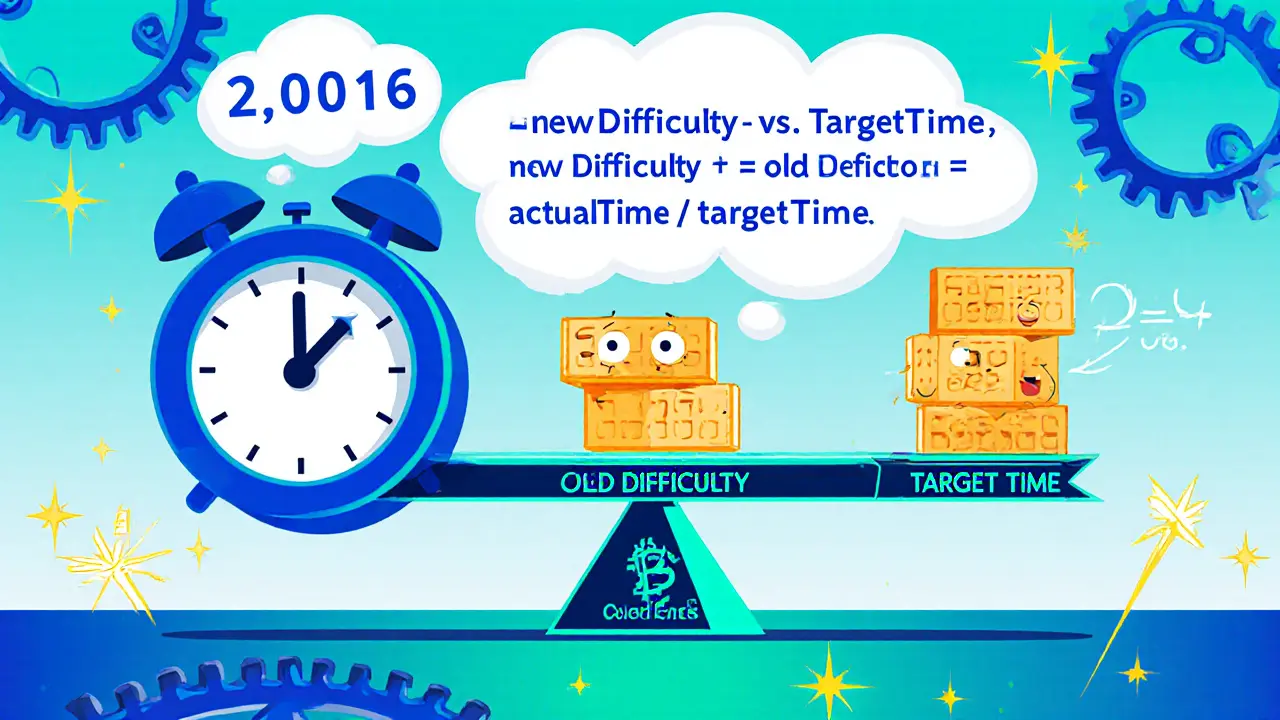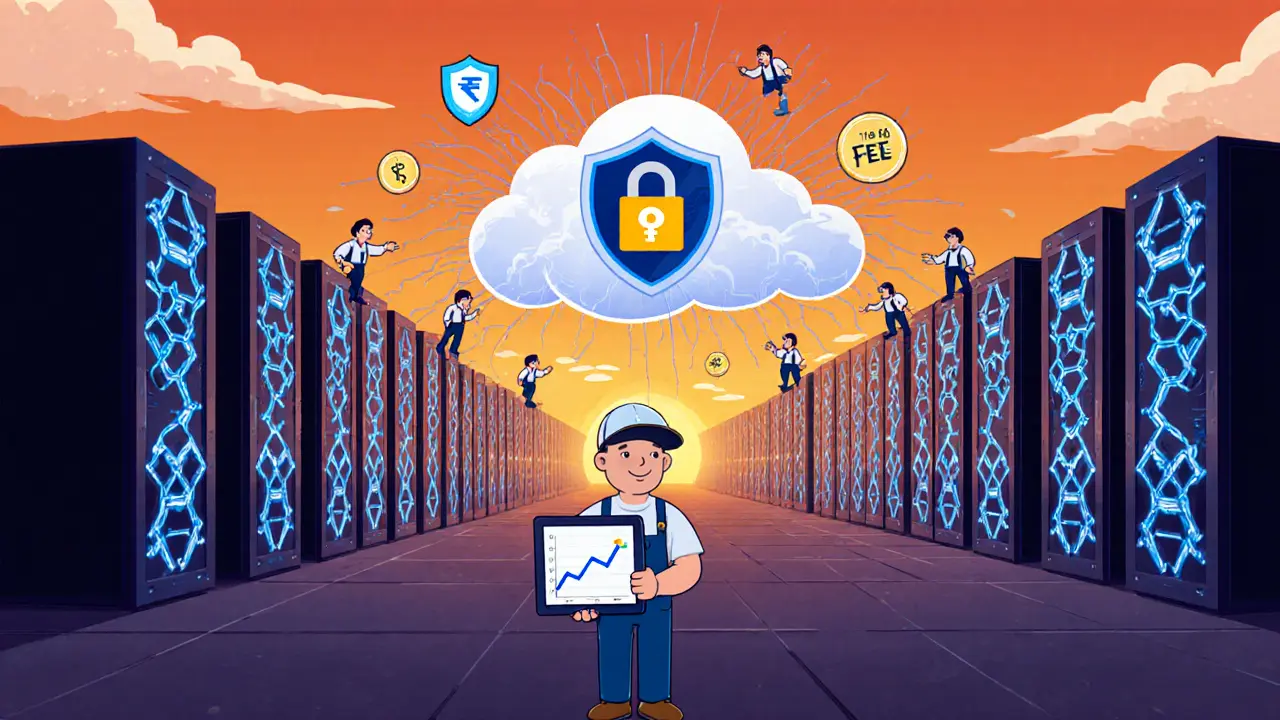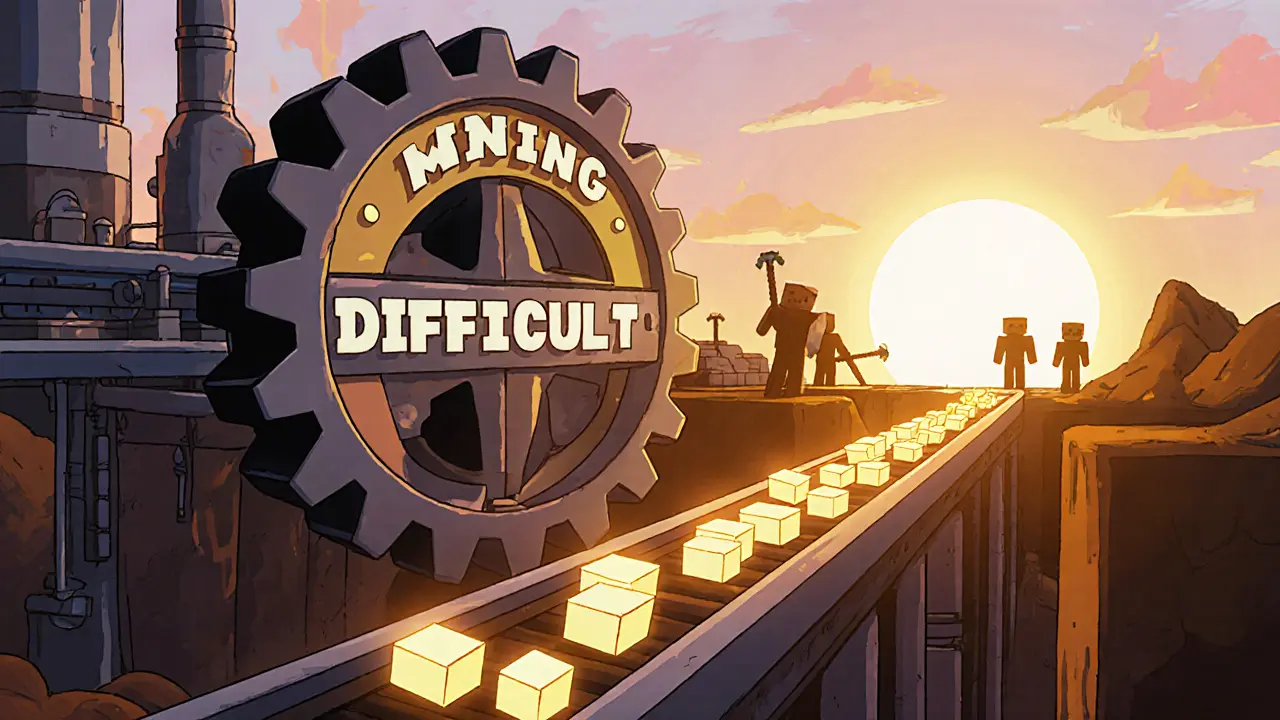Mining Difficulty Adjustment Calculator
Difficulty Adjustment Calculator
Calculate new difficulty based on actual vs target block times using the standard formula
How It Works
The formula used is: newDifficulty = oldDifficulty × (actualTime / targetTime)
Networks apply safety caps limiting changes to 4x in either direction to prevent instability.
Note: Maximum change limited to 4x the current difficulty
When you hear about a blockchain suddenly slowing down or a miner’s profit tanking, the hidden culprit is usually mining difficulty. This metric is the engine that keeps block creation steady, no matter how many miners join or quit. Understanding how it works helps you gauge network security, predict transaction speed, and decide if mining is still worth your electricity bill.
What Mining Difficulty Actually Is
Mining difficulty is a numeric value that tells how hard it is to find a valid block hash in a proof‑of‑work (PoW) blockchain. The higher the number, the lower the chance that any single hash attempt will meet the network’s target, meaning miners must try more hashes before they succeed.
Why Blockchains Need a Difficulty Mechanism
Proof‑of‑work relies on competition: miners race to solve a cryptographic puzzle. If the puzzle stayed the same while more hardware joined the network, blocks would be mined far faster than intended, disrupting transaction confirmation times and inflating the supply of new coins. Difficulty acts as an automatic governor that nudges the puzzle’s hardness up or down to keep the average block interval close to a preset target (10 minutes for Bitcoin, 2.5 minutes for Litecoin, etc.).
How the Adjustment Formula Works
Each PoW chain defines its own adjustment window. Bitcoin, the original design, rewrites difficulty every 2,016 blocks - roughly every two weeks. The network compares the actual time it took to mine those 2,016 blocks with the ideal time (20,160 minutes). The new difficulty is calculated as:
newDifficulty = oldDifficulty × (actualTime / targetTime)
Safety caps limit the change to a factor of four in either direction, preventing sudden swings that could destabilize the network.
Key Players that Influence Difficulty
- Hash rate - the total computational power dedicated to mining. More hash rate = higher difficulty.
- ASIC miner technology - specialized chips that boost hash rate per watt, often spurring difficulty jumps.
- Cryptocurrency price - higher prices attract more miners, pushing the hash rate up.
- Electricity costs and regulations - cheap power zones (e.g., hydro‑rich regions) concentrate mining farms, influencing global hash rate.
- Mining pools - by aggregating smaller miners, pools can keep hash rate stable even when individual participants drop offline.

Historical Growth of Bitcoin’s Difficulty
Bitcoin launched with a difficulty of 1. By December 2012 it had risen to 1.873 trillion, and by February 2024 it sat near 81.7 trillion - a 43,000 % increase over twelve years. This exponential climb mirrors the shift from CPU mining on kitchen tables to massive ASIC farms consuming terawatts of electricity worldwide.
Difficulty Across Different PoW Chains
| Coin | Adjustment Interval | Target Block Time | Typical Difficulty Range (2024) |
|---|---|---|---|
| Bitcoin | 2,016 blocks (~2 weeks) | 10 minutes | 50‑90 trillion |
| Litecoin | 2016 blocks (~3.5 days) | 2.5 minutes | 5‑15 billion |
| Dogecoin | Every block (≈1 minute) | 1 minute | 2‑6 million |
Bitcoin’s long window provides stability but can lag behind rapid hash‑rate spikes. Litecoin’s 3.5‑day window is a middle ground, while Dogecoin’s per‑block tweak reacts instantly but can introduce more volatility.
Impact on Network Security
Higher difficulty usually means a larger hash rate, which translates into a more expensive 51 % attack. For Bitcoin, the cost of acquiring enough ASIC power to out‑hash the entire network runs into billions of dollars, making attacks practically infeasible. However, soaring difficulty can also squeeze out smaller miners, leading to centralization risks where only a handful of industrial farms dominate.
Practical Effects for Miners
Every miner runs a profitability calculator that plugs in current difficulty, electricity price (USD/kWh), hardware efficiency (J/GH), and coin price. A sudden difficulty hike can turn a marginally profitable operation into a loss‑making one overnight. Many miners join pools to smooth out the variance - pools distribute rewards proportionally to contributed hash rate, using the network’s difficulty to estimate expected block finds.

Mining Difficulty for Everyday Users
While you probably don’t run mining rigs, difficulty still matters to you. Higher difficulty can coincide with higher transaction fees because miners prioritize higher‑fee transactions when block space becomes scarce during short‑term hash‑rate dips. Conversely, a dip in difficulty often brings lower fees and faster confirmations.
Future Trends and Research
Ethereum’s 2022 shift to proof‑of‑stake eliminated difficulty from the second‑largest crypto, redirecting miners toward other PoW coins and subtly raising their difficulty levels. Researchers are experimenting with more responsive algorithms that adjust every few blocks while limiting extreme swings, aiming to keep security high without sacrificing energy efficiency. Some proposals even suggest hybrid consensus models that blend PoW difficulty with stake‑based parameters.
Quick Checklist for Monitoring Difficulty
- Visit a reputable block explorer (e.g., blockchain.com for Bitcoin) to see the current difficulty.
- Track hash‑rate trends - a sudden rise usually precedes a difficulty increase.
- Watch coin price movements; bullish rallies often bring new miners online.
- Calculate profitability with up‑to‑date difficulty figures before buying hardware.
- Consider joining a mining pool if your hash rate is below 1 TH/s.
Bottom Line
Mining difficulty is the brain of any PoW blockchain. It self‑regulates the puzzle’s hardness, keeps block times steady, underpins security, and directly influences miner earnings and user transaction costs. By watching the difficulty curve alongside hash‑rate and market signals, you can better understand a chain’s health and decide whether mining still makes sense for you.
How often does Bitcoin adjust its difficulty?
Bitcoin recalculates difficulty every 2,016 blocks, which is roughly every two weeks.
What happens if difficulty rises too fast?
A rapid rise can make mining unprofitable for small operators, pushing them offline and potentially increasing centralization.
Can I mine Bitcoin profitably with a home PC?
No. The current difficulty level means a home PC would never find a block, and the electricity cost would far exceed any reward.
Why does difficulty affect transaction fees?
When difficulty spikes, hash rate can temporarily dip, reducing block space. Users compete by offering higher fees to get included.
Is mining difficulty the same for all cryptocurrencies?
No. Each PoW coin defines its own adjustment period and target block time, leading to different difficulty dynamics.

11 Comments
Lawrence rajini
Bro this is wild 🤯 I just checked my old rig from 2018 and it's basically a paperweight now. Difficulty went from 1 to 81 trillion? That's like trying to win the lottery every 10 minutes. Still love the tech though 💪
Clarice Coelho Marlière Arruda
so like... if my laptop cant mine anymore does that mean im not part of the blockchain anymore? idk just wondering
Matt Zara
Honestly this post cleared up so much for me. I used to think difficulty was just some random number. Now I get why my friend's ASIC farm in Georgia is always running full tilt. It's not just about power - it's about survival. And yeah, pools are the real MVPs for regular folks.
Jasmine Neo
This is why US mining dominance is bullshit. China crushed this years ago with cheap hydro and state-backed ops. Now we're all just paying for electricity to keep a glorified casino running. And don't even get me started on how this 'decentralization' is just 5 mega-farms controlling 80% of hash power. Wake up.
Jean Manel
Let’s be real - anyone still mining Bitcoin with a home PC is either delusional or paying for it with their rent money. The fact that people still believe this is 'democratic' is the real scam. You’re not a miner. You’re a consumer of FOMO.
Brian Collett
I’ve been tracking Dogecoin’s difficulty every block and it’s wild how it bounces around. One minute it’s 2.1M, next it’s 5.8M because some whale bought 200 new ASICs. It’s like a rollercoaster with no seatbelts. But hey, at least it’s fast.
Lena Novikova
You think difficulty is bad wait till you see how fast Ethereum devs changed the rules after they ditched PoW. Now all the miners are flooding into Litecoin and Doge like it’s a last call at a bar. The whole system is just a game of musical chairs with GPUs
Allison Andrews
There's something deeply poetic about a system that adjusts itself to maintain balance - even as humans keep trying to game it. The difficulty isn't just math. It's a silent contract between technology and greed. And yet, we still keep playing.
Cory Munoz
I appreciate this breakdown. I used to think mining was just about buying the newest rig. Now I see it's more about timing, location, and patience. I'm not going to mine, but I respect the people who do. It’s not easy, and it’s not fair. But it’s real.
MICHELLE SANTOYO
What if difficulty isn’t the solution - what if it’s the problem? We’re chasing stability in a system built on volatility. Maybe the real innovation isn’t adjusting difficulty… but killing it entirely. PoW is just capitalism with more wires.
William P. Barrett
The beauty of mining difficulty is how it turns chaos into rhythm. Every miner, every ASIC, every watt of electricity - they’re all whispering to the network, and the network whispers back with a new number. It’s not just code. It’s a conversation between machines that somehow keeps the whole thing alive. No one planned this. It just… evolved. And somehow, it works.